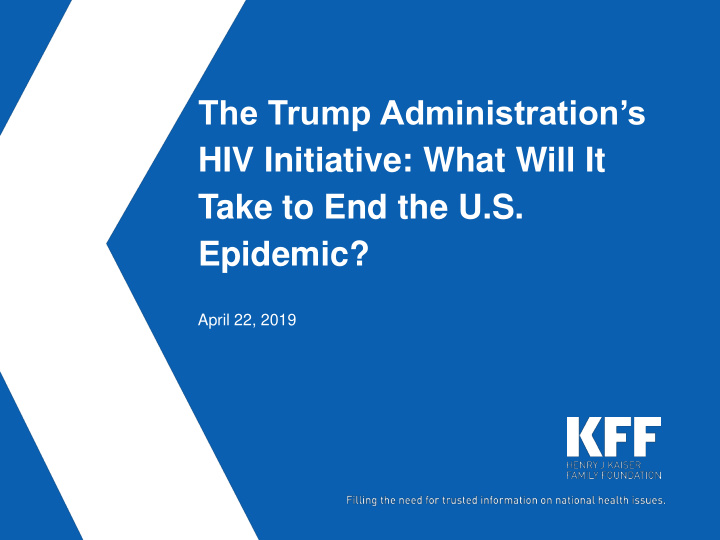



The Trump Administration’s HIV Initiative: What Will It Take to End the U.S. Epidemic? April 22, 2019
HIV Viral Suppression Rate in U.S. Lowest Among Comparable High-Income Countries 84% 84% 83% 77% 76% 74% 74% 74% 70% 68% 63% 54% United Switzerland Sweden The Germany France Australia Austria Japan Belgium Canada United Kingdom Netherlands States NOTES: All data are for 2018 except for Canada (2016) and Japan (2015). U.S. estimate based on Bradley et al. “Data -Driven Goals for Curbing the U.S. HIV Epidemic by 2030,” AIDS and Behavior, 2019. All countries defined viral suppression as having a viral load test result of < 200 copies/ mL. SOURCES: Public Health Agency of Canada, 2018; The Kirby Institute for infection and immunity in society, 2018; European Centre for Disease Prevention and Control, 2018; Bradley H, Rosenberg ES & Holtgrave DR, “Data -Driven Goals for Curbing the U.S. HIV Epidemic by 20 30,” AIDS and Behavior, 2019; Iwamoto A et al., “The HIV care cascade: Japanese perspectives,” PLoS ONE, 2017.
National HIV Incidence is no Longer Falling; Epidemic is Concentrated HIV Incidence, 2010-2016 Among all people with HIV 1 : 50% live in 5 states 42% are Black/African American 45% live in the South 62% are MSM 2 2010 2011 2012 2013 2014 2015 2016 NOTES: (1) Includes those with diagnosed and undiagnosed HIV. (2) Includes MSM/IDU. SOURCES: CDC. HIV Surveillance Supplemental Report. Vol. 24, No. 1. Estimated HIV Incidence and Prevalence in the United States 2010 – 2016.
Federal Funding for Domestic Discretionary HIV Programs Has Been Relatively Flat for Several Years Funding in Billions $7.7 $7.7$7.6 $7.7 $7.8 $7.7 $7.5 $7.3 $7.1 $7.3 $7.0 $6.8 $6.7 $6.5 $6.5 $6.4 $6.3 $6.1 $5.8 $5.1 $4.8 $4.2 $3.9 $3.5 $3.3 $3.2 $2.6 $2.4 $2.3 $1.9 $1.5 $1.1 $0.6 $0.0 $0.1 $0.1 $0.3 <$0.0 FY 1981 FY 1983 FY 1985 FY 1987 FY 1989 FY 1991 FY 1993 FY 1995 FY 1997 FY 1999 FY 2001 FY 2003 FY 2005 FY 2007 FY 2009 FY 2011 FY 2013 FY 2015 FY 2017 FY 2019 Source: Kaiser Family Foundation analysis of data from OMB, CBJs, Congressional Appropriations Bills, and personal communication with agency staff. Notes: Funding includes both domestic and global HIV accounts; The decrease in 2006 reflects methodological changes at CMS. For additional information about recent budget trends see KFF fact sheet, U.S. Federal Funding for HIV/AIDS: Trends Over Time. https://www.kff.org/global-health- policy/fact-sheet/u-s-federal-funding-for-hivaids-trends-over-time/
FY 2020 Budget Request Would Mark First Significant Increase for Ryan White & CDC in Years CDC HIV Prevention Funding, FY1981- Ryan White Funding, FY1991- FY2020 FY 2020 Budget Request (BR) Budget Request (BR) Funding in Millions Funding in Millions $929 $2,389 $823 $2,337 $2,319 $2,319 $787 $789 $732 $750 $732 $2,138 $2,018 $617 $498 $1,436 $378 $656 $136 $257 $6 3% over FY19 funding 18% over FY19 funding SOURCE: Kaiser Family Foundation analysis of data from OMB, budget request, CBJs, Congressional Appropriations Bills.
Demographic & Policy Snapshot of Targeted Jurisdictions Southern % Uninsured % in Poverty Region > National Avg. > National Avg. 23 counties 31 counties 30 counties 6 states 3 states 6 states DC Medicaid Ryan White Community State Expansion Part A Health Centers Prohibition on 30 Counties 47 counties 48 counties Syringe Access 7 counties 2 states 2 states 7 states 6 states DC + San Juan DC + San Juan DC + San Juan SOURCES: HHS, Ending the HIV Epidemic, List of Counties, Territories, and States. KFF State Health Facts; CDC Supplement Surveillance Report. Vol. 23, No. 7: HIV and AIDS Data through December 2016 Provided for the Ryan White HIV/AIDS Program, for Fiscal Year 2018; US Census American Fact Finder; NASTAD. Syringe Service Program Policy Environments Across the United States. HRSA Fact Sheets from data.hrsa.gov.
Majority Say HIV/AIDS is a Serious Issue for the U.S. Today; Half Say it is a Serious Concern For People They Know Very serious Somewhat 24% serious 22% Very serious 34% How serious How serious of a Somewhat of an issue do concern do you serious you think 46% think HIV/AIDS is DK/Refused HIV/AIDS is for people you 4% for the U.S. Not too know ? today ? serious 25% Not at all Not at all serious serious 24% DK/refused Not too 4% 3% serious 13% SOURCE: KFF Health Tracking Poll (conducted March 13-18, 2019). See topline for full question wording and response options.
Most have not heard about the Administration's “Plan to End HIV,” but are Optimistic about its Goals Don't Know (2%) Have Heard (8%) Cannot Share of Share of Accomplish (48%) Americans that Americans that believe the goal have heard of of reaching zero Administration's “Plan to End new infections HIV” Can by 2020 can be Accomplish reached. (52%) Have Not Heard (92%) SOURCE: KFF Health Tracking Poll (conducted March 13-18, 2019). See topline for full question wording and response options.
Significant Gaps Remain in the Public’s Knowledge of HIV Treatment and Prevention Don’t know Very effective Somewhat effective Not too effective Not at all effective How effective are ARVs at improving the health of 27% 45% 7% 17% 4% people with HIV? How effective are ARVs at preventing the spread of HIV to 15% 37% 13% 12% 22% sexual partners? Yes No Don't know As far as you know, is there a prescription medication that 42% 40% 18% people who are HIV-negative can take to lower their risk of getting HIV? SOURCE: KFF Health Tracking Poll (conducted March 13-18, 2019). See topline for full question wording and response options.
Panelists • Heather Hauck, Deputy Associate Administrator, HIV/AIDS Bureau, Health Resources and Services Administration (HRSA) • Kendra Johnson, Director, STD/HIV Office, Mississippi Department of Health • Michael Kharfen, Senior Deputy Director, HIV/AIDS, Hepatitis, STD and TB Administration, District of Columbia Department of Health • Jesse Milan, Jr., President and CEO, AIDS United • Dr. Melanie Thompson, HIV physician and researcher, Atlanta, GA
Recommend
More recommend